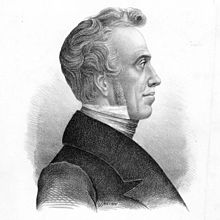This article has multiple issues. Please help improve it or discuss these issues on the talk page. (Learn how and when to remove these messages)
|
Sigismund Neukomm or Sigismund Ritter von Neukomm [after ennoblement as a knight] (10 July 1778, in Salzburg – 3 April 1858, in Paris) was an Austrian composer and pianist.

Neukomm first studied with the organist Weissauer and later studied theory under Michael Haydn and Leopold Mozart, though his studies at Salzburg University were in philosophy and mathematics. He became honorary organist at the Salzburg University church in 1792, and was appointed chorus-master at the Salzburg court theater in 1796.
Neukomm left Salzburg at the end of March 1797, moving to Vienna in order to study with Joseph Haydn; his studies lasted seven years. Neukomm venerated his teacher, as is known from the many remarks he made to others and from the many times he dedicated his musical works to Haydn. He performed a number of services for his teacher: he made arrangements of The Creation (Haydn), Il ritorno di Tobia, The Seasons and the cantata Arianna a Naxos, as well as transcriptions of various symphonies for harmonium and piano. By 1804, when the declining Haydn was no longer able to compose, he took over the task of making arrangements of 43 Scottish folk songs.[1] In Vienna Neukomm also gave piano and singing lessons; his pupils included Anna Milder and Franz Xaver Mozart.
On 5 May 1804 he left Vienna for St Petersburg. Neukomm was kapellmeister at St. Petersburg's German theatre from 1804 to 1809, and in the 1810s he spent time in Brazil, South America, where he popularized the works of Joseph Haydn and Wolfgang Mozart. He worked at D. João VI's court in Rio de Janeiro. His works had some currency in the nineteenth century: Johann Nepomuk Hummel's op. 123 is a Fantasie for Piano on themes by Hummel and von Neukomm. Boston's Handel and Haydn Society, for example, gave 55 performances of his oratorio David during the 1830s.[2]
Neukomm's compositional output is large. With the older composer's approval he made arrangements of Haydn's works, including the oratorios The Seasons and The Creation. He wrote a clarinet quintet, several organ voluntaries, ten operas, incidental music for four plays, forty-eight masses, eight oratorios, and a large body of smaller works including vocal pieces, works for piano solo, and about 200 songs.
In 1814 Neukomm was responsible for erecting a tombstone to the memory of Haydn over his first grave in the Hundsturm cemetery in Vienna. The inscription included a puzzle canon composed by Neukomm himself. He had previously been one of Haydn's pupils, and was also in regular contact with the composer in the last months of his life.
The following year, his Requiem Mass à la mémoire de Louis XVI commissioned by Talleyrand, premiered for royalty and diplomats attending the Congress of Vienna on 21 January, the 22nd anniversary of the execution of Louis XVI in 1793.
References
edit- ^ Source for Haydn material: Grove Music Online, article by Rudolf Angermüller
- ^ Harold Earle Johnson, Hallelujah, Amen!: The Story of the Handel and Haydn Society of Boston (Boston: B. Humphries, 1965), 52-4
Sources
edit- Vincenzo Cernicchiaro. Storia della musica nel Brasile. Milano, Fratelli Riccioni, 1926.
- Don Randel. The Harvard Biographical Dictionary of Music. Harvard, 1996, p. 633.